Fortunately for chair dwellers, the development of a variety of standing and lifting wheelchairs in recent years is allowing us to upgrade to a bird’s eye view within a matter of seconds. Besides the higher vantage point, standing wheelchairs have been proven to promote a variety of health benefits including stronger bones, pressure relief, less spasticity, better digestion, increased lung capacity, and improved bowel and bladder control.
Here are five popular standing wheelchairs on the market and stories of people who own them.
Redman Power Chair Chief 107-ZRX
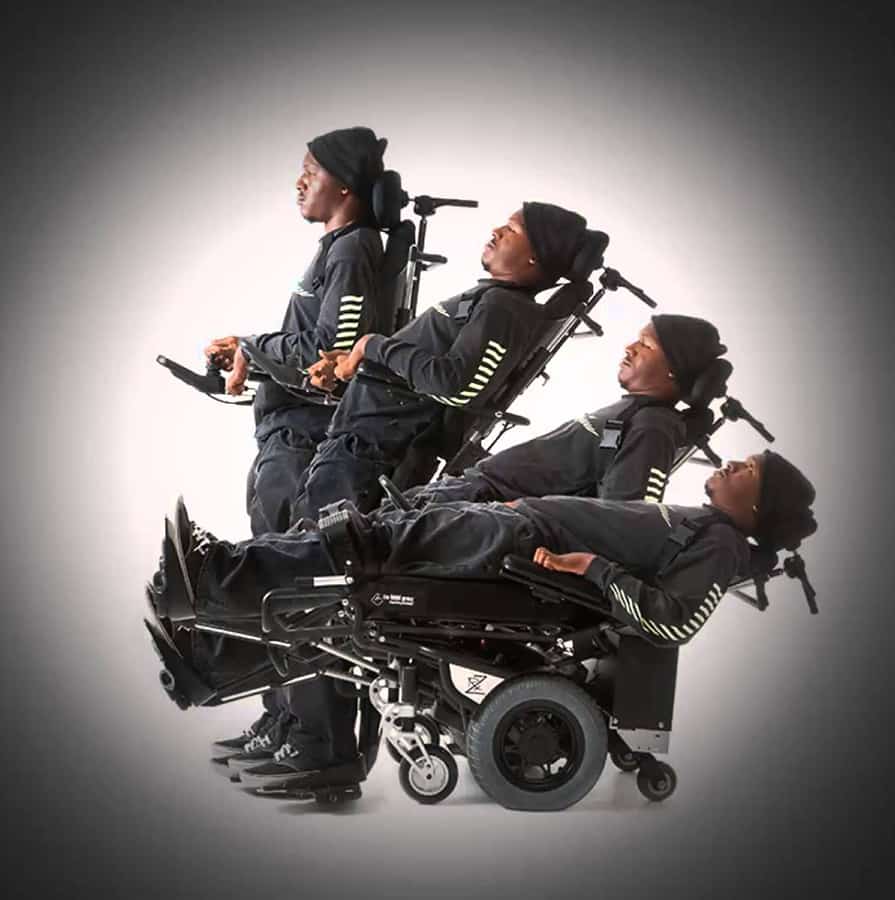 Redman Power Chair: redmanpowerchair.com
Redman Power Chair: redmanpowerchair.com
Positions: Standing, blended stand, tilt, recline
Speed: 9 MPH, seated
“My neighbor got a kick out of watching me chase my horses through sagebrush to get them back home, seated in my wheelchair, and strapped in good,” says Robert Nedens, 65, a C3 complete quad. Nedens rides a Redman Chair Chief 107-ZRx on his Billings, Montana, ranch, and has ridden Redman chairs since leaving rehab after his injury in 2003.
“Sam Redman brought the chair to Craig Hospital and let me try it out, and I liked the looks and performance,” says Nedens. “The hospital pressure-mapped the chair and it proved to be exemplary.”
It was difficult for Nedens’ body to acclimate to the upright position at first. “I had a hard time with my blood pressure and would pass out before I got all the way up,” he says. But he pushed himself to use it consistently and has logged over 1,000 miles since his first Redman.
Nedens says he likes the variety of positional options. “I stand for long periods of time, but I also can do a combination of seating positions,” he says. “I can put my legs partially up with a small amount of recline and partial stand (blended stand), or legs straight out and full recline (a horizontal position). It also allows me to stand and recline to a bending backwards position (yoga).”
But don’t try the standing feature on a sharp incline, Nedens warns. “You get on a steep enough hillside and it will tip over. I did that, and there was no damage to the chair or me. I just had to wait for someone to set me up,” says Nedens, who uses sip-and-puff to control the chair.
Nedens values the impact the Redman has had on him in social situations. “Sometimes people in wheelchairs are ignored. I find when I stand with everyone else I am more included in the conversation,” says Nedens. “The chair is very dependable, and I’m comfortable rolling around on my own. After rehab I’ll stay in town and either go downtown or to a park, just have to let the wife know where I’ll be so she can pick me up after work.”
On the cusp of getting his third chair from Redman, Nedens says they have a long history together and almost feel like family.
“I encourage getting a standing wheelchair, one that’s easy to work on, with a good support team and I have that with Redman,” he says. “In the past I have checked out other wheelchairs, and the best choice for me is still Redman.”
And he adds he is grateful for the smooth buying process. “Private insurance paid for my first one and after that Medicare covered 80 percent. Also had a trade-in allowance,” he says. “Redman handled all of the purchasing process.”
Tek RMD
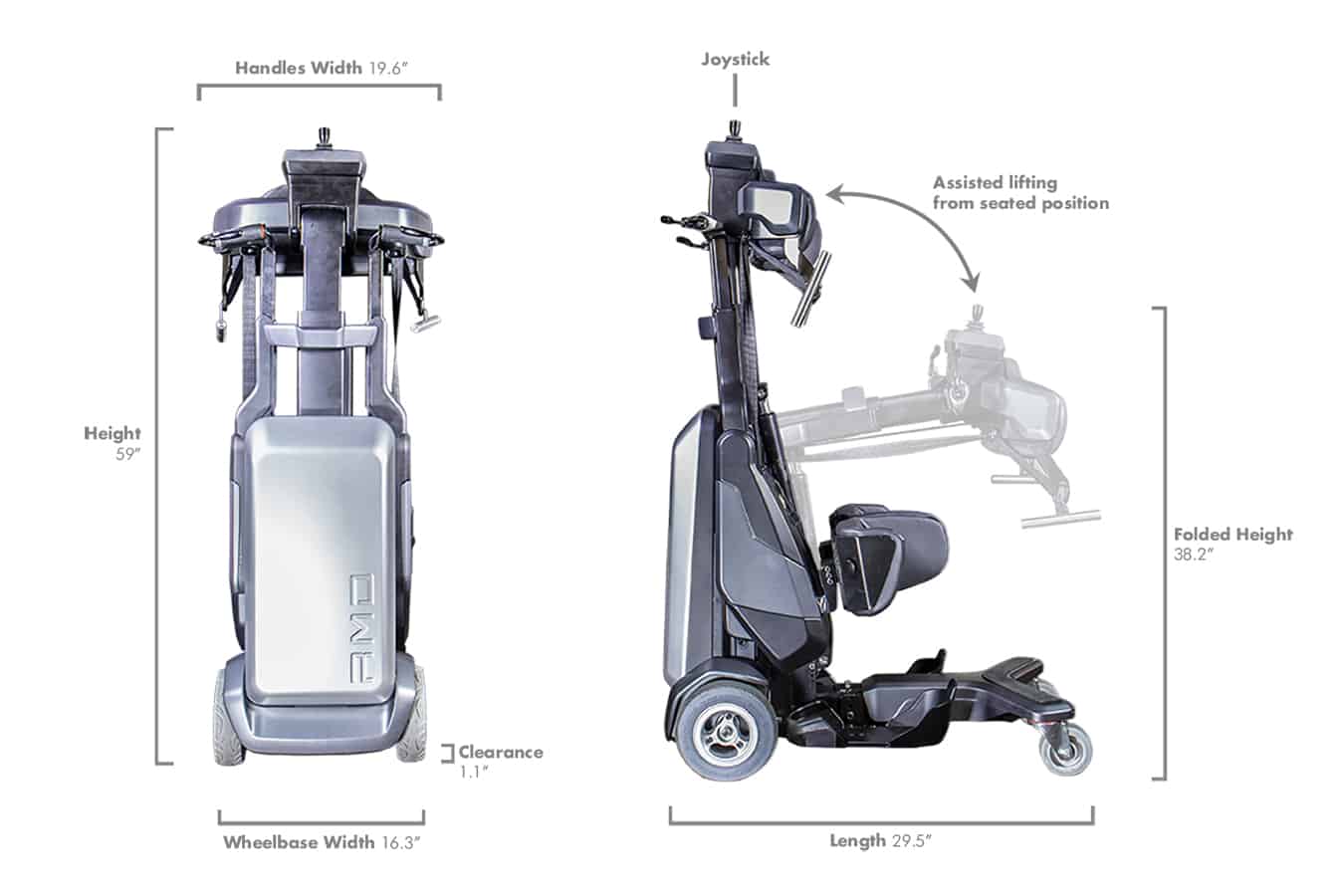 Tek RMD: matiarobotics.com, innovationshealth.com
Tek RMD: matiarobotics.com, innovationshealth.com
Positions: Standing, sitting for limited periods
Speed: 3 MPH, while standing
At first glance, it looks like Troy Yoho, 47, is using a Segway to zip around Hill Air Force Base in Northern Utah, but the calibration contract manager is actually scooting around in a Tek Robotic Mobilization Device. Created in 2012, the Tek RMD is designed solely for standing, and allows paraplegics and others with good upper body strength to get out of their wheelchair, stand and move around on smooth surfaces.
Injured in 2013 at the T12 level, Yoho decided to get a Tek in February 2016 to gain the benefits of standing during his eight-hour work day. “I stand approximately four hours a day in it,” says the Air Force veteran. “It keeps me off my back side from sitting all day and hopefully with less break down of my body.”
Yoho says he has seen many improvements to both his health and well-being and his social interactions with colleagues. “What’s amazing about it is the ability to be up vertical for long periods of time and having eye-to-eye communication with my coworkers,” he says. “My core strength has also improved, and I have been able to stretch my leg muscles, hamstrings and hips.”
On the flipside, Yoho, who has good upper body strength, says it is difficult to transfer into the device. “I have improved my technique, but my pants ride up when I get in and it’s near impossible to get them pulled down by myself,” he says.
He also wishes the device had more storage options for everyday items like papers and pens. “I can put some things in my pocket, but I’m limited on carrying stuff.”
The Tek can only be used independently by people who have upper body strength, hand dexterity and a good grip, but the company says quads can use it if they have assistance.
Unfortunately, because it is so new on the market, Tek does not currently have a Medicare reimbursement code, which is needed for Medicare, Medicaid and many other private insurances. “It bums me out so bad,” says Yoho, who bought the chair with his own money. “My insurance would not pay anything. It stinks because the health improvement is so beneficial, especially the lower chance of pressure sores and improved circulation. I just don’t understand why they won’t approve.”
Permobil F5 Corpus VS
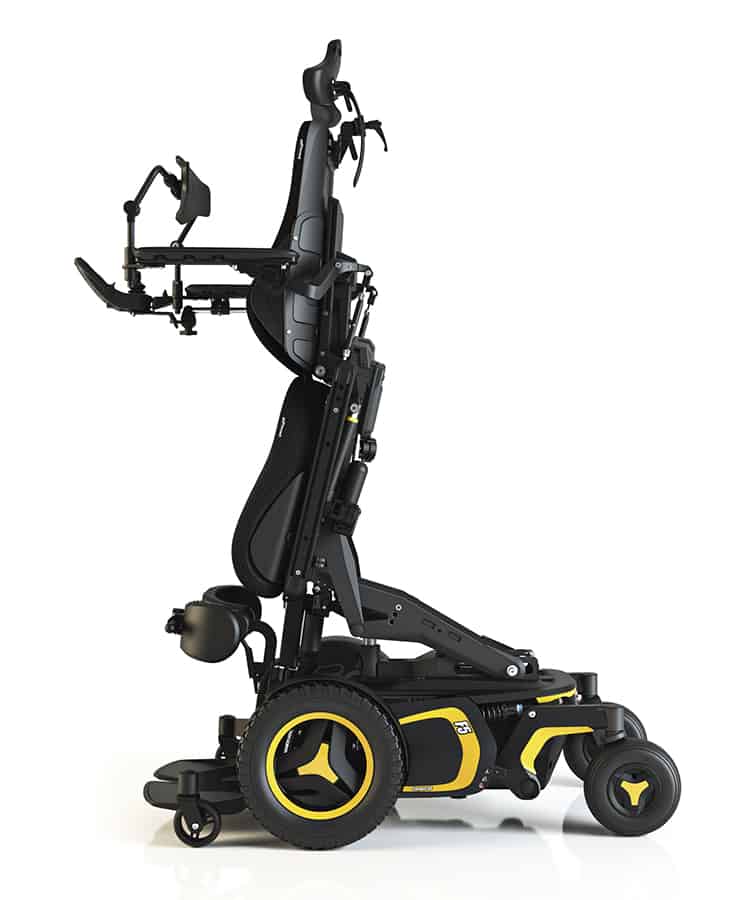 Permobil: permobil.com
Permobil: permobil.com
Positions: Standing, sitting, recline, tilt, power leg rests, seat-elevated
Speed: 7.5 MPH, seated
As creator of beyond-disabilities.org, Steve Ferreira, 27, has spent the past 12 years speaking to over 500 regional high schools, colleges, churches, graduations and other venues to educate the public on the disabled population’s unrecognized talents and inspire others with disabilities to realize their own potential. But working to encourage others left the Seattle native neglecting his own health and long overdue for a new wheelchair.
“I received my old wheelchair about 15 years ago when I was in middle school. Needless to say, it was falling apart and I needed a new one,” says Ferreira, who has cerebral palsy. “I had been having back problems from my old chair, and my therapist thought the ability to stand would improve my overall health, as well as help me to reach things when I worked.” Ferreira decided on a Permobil F5 Corpus VS, which has four power seat functions — tilt, recline, power leg rests and a seat elevator — plus the ability to stand.
Although he has only had the chair for a few months, Ferreira says it has been a game changer for his health, independence and busy career. “The sit-to-stand feature gives me the ability to stretch my legs. It’s also great for weight bearing and breathing,” says Ferreira. “When I go to a restaurant with a high table, I can now raise up to it. Also, while speaking, it’s great to be able to face an audience and look them in the eye.”
The only downside? Because of insurance obstacles, Ferreira says the process of getting the Corpus VS was a nightmare and took two full years.

“We had to have a physical therapist write a letter and also needed a doctor’s prescription before submitting the request to insurance. I’m covered under Regence from my mother’s office and Medicaid is my secondary insurance. Both insurances only approved part of the wheelchair. We were denied the sit-to-stand feature as well as other parts of the chair like the footrest and recline,” says Ferreira. Their appeal was denied and eventually his mother became frustrated and self-paid the last portion. “I finally received my chair in March. We paid for about $9,000 toward the $45,000 chair.”
Overall, Ferreira says the chair’s many benefits overshadow the frustrating purchasing process. “If someone is on the fence, I would say go for it,” he says. “The chair is truly life changing.”
Levo C3
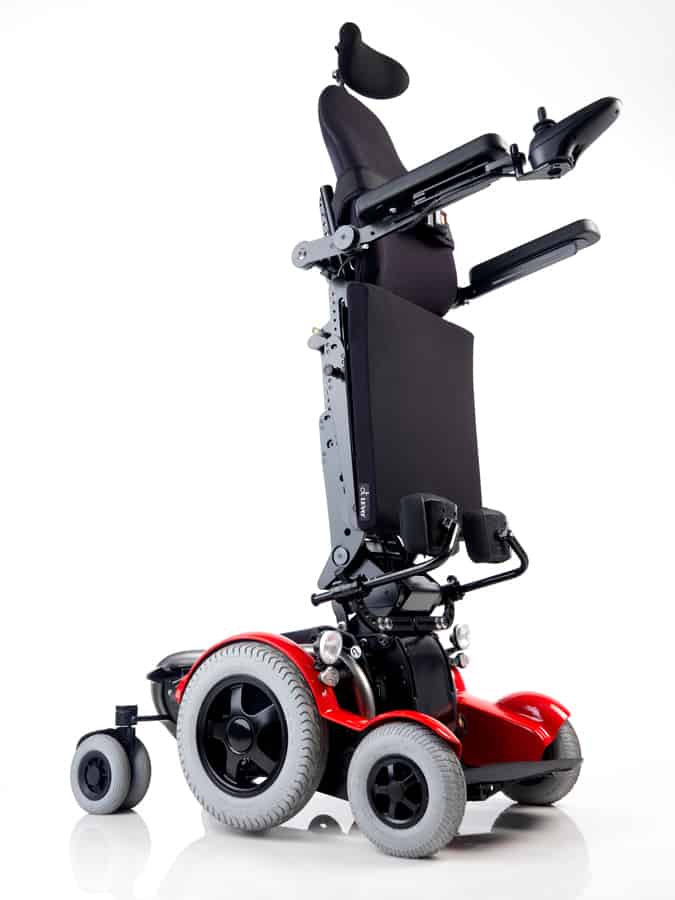 Levo: levousa.com
Levo: levousa.com
Positions: Standing, sitting, tilt
Speed: 6 MPH, seated
Tobin Boenig, 43, credits using a standing chair soon after his C4-5 incomplete injury two decades ago for his increased movement and function.
“My physical therapist thought it would aid in my efforts to potentially walk again,” says Boenig, an attorney from Houston, Texas. “While I never was able to walk in my ‘everyday life’ routines, I was able to use a walker with forearm platforms for about a quarter of a mile. I am convinced that regularly standing in my wheelchair helped with that effort.”
Boenig has had an older model Levo standing chair since 2002 and reflects on the milestones the chair has helped him conquer. “I have used my standing feature to deliver speeches, dance, exercise, and even to exchange my wedding vows with my wife,” he says. “I think it has helped me to stay healthier, both mentally and physically.”

Wanting an upgrade, Boenig is getting ready to purchase the latest C3 model. “The tilt function is something I am looking forward to for pressure relief,” he says. “This old Levo of mine doesn’t handle well on rough terrain, but the new Levo that I tried handles it much better.”
The Levo C3 power chair features dual drive, meaning both the front and mid wheels are powered. It’s built to take on outdoor terrain, but only in the sitting position — the standing function should only be employed on solid, flat, level and obstacle-free surfaces. In a seated position, the C3 is also able to climb up to 4-inch curbs allowing the user to bypass many curb cuts completely.
As for whether his insurance will cover it, Boenig is crossing his fingers. “I should know in a few weeks. I am going through the insurance process as we speak,” he says.
Quantum Rehab iLevel
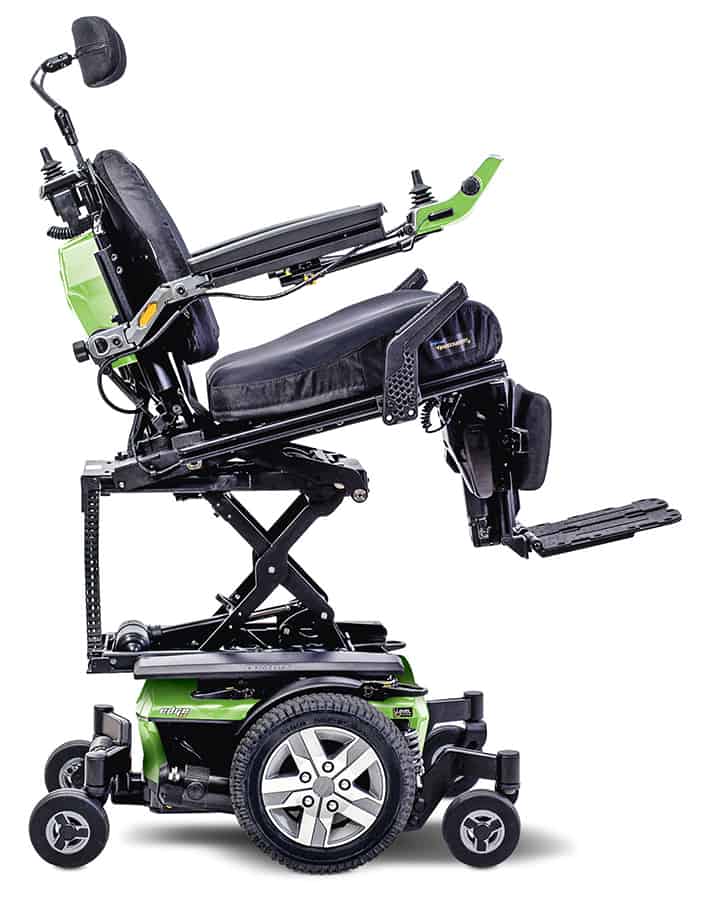 Quantum Rehab: quantumrehab.com, ilevel.rehab
Quantum Rehab: quantumrehab.com, ilevel.rehab
Positions: Tilt, recline, elevate
Elevation: 10 inches walking speed of 3.5 MPH
Speed: 6 MPH standard,when not elevated
Quantum Rehab’s iLevel is not a standing chair, but it is an elevating chair that allows you to drive around at normal speeds while elevated, and that’s exactly what Florida native and former police officer Rich Pollock, 36, wanted.
“I enjoy going to Disney with my family,” says Pollock, diagnosed with ALS in 2014. “When I started using a scooter, I constantly had to keep asking my wife where my daughter was. I couldn’t see her because I was below crowd level. This was not acceptable to me.”
Knowing a standing chair would not be feasible for his progressive disease, he decided to purchase a Q6 2.0 with iLevel adjustable-base power chair from Quantum Rehab. The iLevel elevates up to 10 inches and moves 3.5 miles per hour while elevated, but should not be used on rough terrain — it’s best used indoors.
In addition to elevating, Pollock appreciates the iLevel’s recline position. “Using this feature is a godsend because my legs and feet begin to swell and it allows me to elevate my feet while lowering my upper body. The head rest and associated neck support are also excellent, because I have lost strength and function in those muscles.”
Pollock also appreciates the impact the iLevel has on his emotional health. “I am no longer down at kid level. I have also always been the ‘cook’ in our family and in a regular chair that wasn’t possible,” he says. “When you are diagnosed with something such as ALS and you know that you are going to progressively lose the ability to do everything, this is a bright spot in the midst of that darkness.”
Jeanne Allen, 61, of Sonoma, California, had an “aha” moment when she saw an elevating wheelchair at local abilities expo in 2014. Desiring a seated chair that lifts up to standing height, Allen, whose MS is progressing, opted for Quantum Rehab’s Q6 Edge X lifting base chair, an older version of the company’s iLevel base.
“MS fatigue is one of my symptoms and the tilt/recline allows me to rejuvenate by getting myself into a comfortable resting position, even napping in my chair,” says Allen, founder of incredibleACCESSIBLE.com. “I also have edema in my feet and the tilt/recline allows me to lean back and raise my feet above my body to reduce the swelling.”
Like others who use standing or elevating wheelchairs, Allen credits the Edge with improving her social life. “When I’m in the elevated position, my husband can put his arm around me and give me a kiss,” she says. “I can be in a standing crowd and see what everyone else is seeing, or browse through the clothing racks at hanger height. I’m no longer sitting while everyone else is standing.”
Support New MobilityWait! Before you wander off to other parts of the internet, please consider supporting New Mobility. For more than three decades, New Mobility has published groundbreaking content for active wheelchair users. We share practical advice from wheelchair users across the country, review life-changing technology and demand equity in healthcare, travel and all facets of life. But none of this is cheap, easy or profitable. Your support helps us give wheelchair users the resources to build a fulfilling life. |




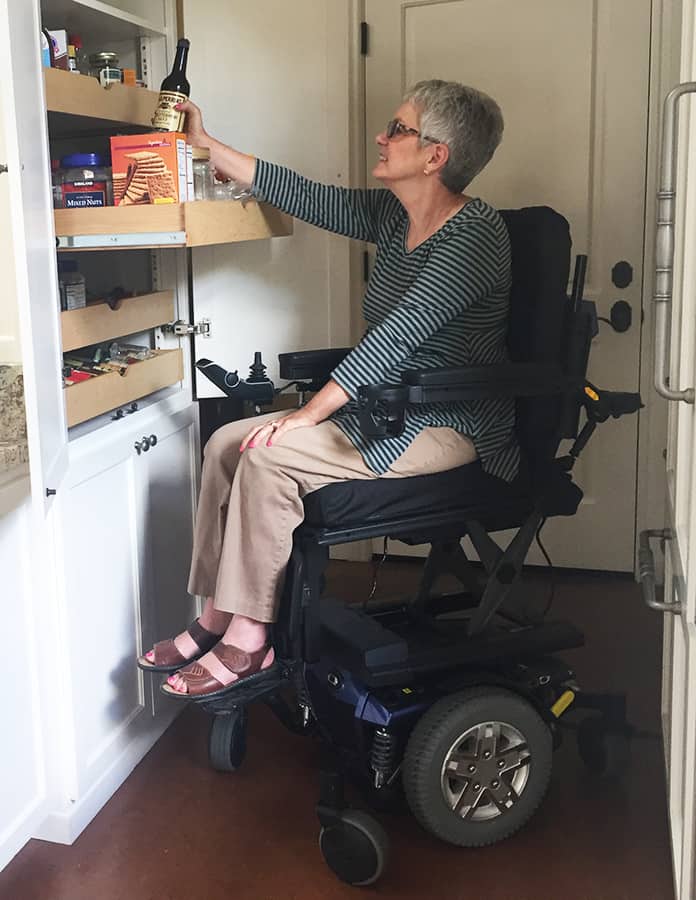
Recent Comments
Sue on Controller Recall Puts SmartDrive Safety in the Spotlight
David Anderson on Phoenix i is the First Wheelchair with Integrated Power Assist
Dan on Phoenix i is the First Wheelchair with Integrated Power Assist